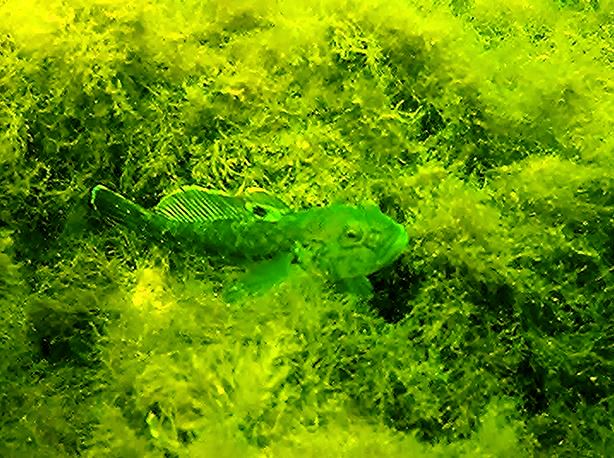















Technician Ryan Glasford pulls in a gill net
Harbor breakwalls and jetties are common features on many cities’ waterfronts, and they can be home to a surprising abundance of aquatic life. These structures are typically created from massive (i.e. 20,000 lb) “armor stones”, or chunks of concrete, which may not provide truly ideal habitat for attracting and producing valuable fish and invertebrate communities—there just aren’t enough crevices, or interstitial spaces, for fauna to seek shelter or to be desirable spawning grounds for fish. As a potential solution, the U.S. Army Corps of Engineers installed 1,000 meters of cobble-sized rubble along Milwaukee Harbor’s northeast wall as part of the “Green Breakwall” initiative in 2014.
As a research technician in a fisheries ecology lab at the University of Wisconsin-Milwaukee School of Freshwater Sciences, I, along with the lab’s P.I. and an M.S. student conducted the USACE’s biological assessment of this artificial habitat. Fish taxon abundance and possible spawning activity were documented along ten visual survey transects on weekly night dives, and two 50 meter micromesh gill nets were deployed overnight on a weekly basis. Invertebrate communities were assessed via rock scrapes for epibenthic taxa, and using custom-built “funnel traps” for pelagics (see photo, above). Stomach contents were also analyzed for subsets of each fish species collected.
Fish taxa observed and/or collected included Rock/Smallmouth/Largemouth bass, walleye, Northern pike, Yellow perch, Rainbow/Brown trout, Rainbow smelt, Gizzard shad, alewife, White sucker, stickleback, and the ever-present Round goby. Spawning sites and fry were documented for all three bass species (see photos, above). The macroinvertebrate community (excluding dreissenid mussels) was largely dominated by amphipods, isopods, and the relative newcomer, Hemimysis anomala, the “blood-red shrimp”.
Hemimysis and the new Great Lakes nearshore food web
Hemimysis anomala (photo credit: U.S. Geological Survey)
Not actually true shrimp, Hemimysis hail from the same region (Ponto-Caspian) as the dreissenid mussels and Round gobies before them, likely also introduced through ballast water from international ships. First discovered in Lake Michigan in 2006, dense swarms now inhabit rocky nearshore zones in all but Lake superior. In our study, virtually every fish species’ stomachs were packed with the tiny crustaceans (below, right). The lack of pelagic food sources for native fish since the dreissenid mussel invasions of the 90s and early 2000s was, and is of major concern, but Hemimsysis appear to be providing some measure of a solution, at least in the nearshore.
Alewife with gut full of Hemimysis (photo credit: Eric Geisthardt)
It’s no secret that the Great Lakes are flush with non-native species. From lamprey to alewife to pacific salmon, to dreissenid mussles to Round gobies, this is a geologically very young and ecologically dynamic system, with resource bases/niche spaces ripe for exploitation. Given the ‘success’ of these non-natives, especially the mussels, which fundamentally changed the ecology of four out of five lakes in roughly a decade from offshore/pelagically driven to nearshore/benthically driven systems (see Hecky et al’s seminal 2004 paper), an ecologist working on Lake Michigan today is essentially studying a completely novel ecosystem compared to his or her counterpart just a generation ago. Non-native or invasive species definitely get a ‘bad wrap’, and rightly so much of the time; but, as most are here to stay in the Great Lakes, seeking to understand these species’ roles in food webs is becoming increasingly important. And, in some cases, like that of Hemimysis, real benefits may extend to valuable native species as well.
This work was funded by the United States Army Corps of Engineers.


